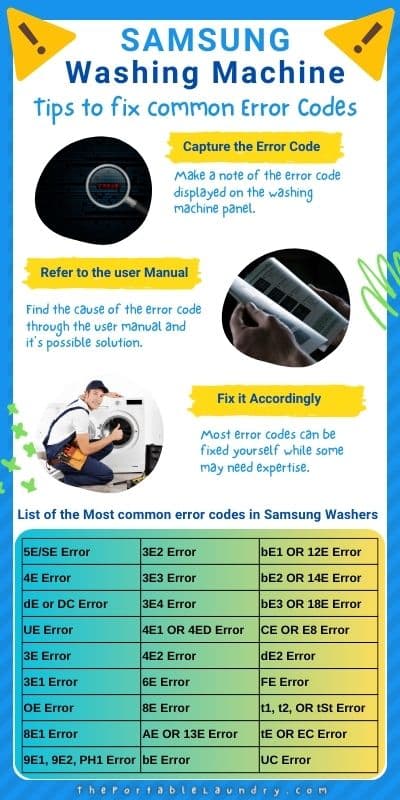In this article, we will go through some common Samsung Washing Machine Errors along with the solutions.
In fact, we have covered almost 27 error’s that you can possibly get in almost all modern-day Samsung washers.
Let’s look into each of the errors and solutions below.
Table Of Content

5E/SE Error
This error means your Samsung washing machine is experiencing difficulties when draining water.
Solution: To solve it, use the restart button to reset and attempt draining the water. If this fails, there is a possibility of a blockage in the drainage system. The machine’s filter catches loose debris and coins from clothes pockets, which blocks the appliance’s drainage system. If the washing machine is attached to a sink, there may be accumulated deposits such as fats, or if you have moved to a new house, make sure there is no cap blocking the drain pipe.
4E Error
4E error simply means the water getting into the machine is not enough.
Solution: Use the reset button to restart the appliance and if it does not work use the following steps:
- Check if the hose is attached correctly and ensure it’s not squashed or split.
- Check your water supply; its pressure may be too low, or the pipes are frozen.
dE or DC Error
This type of error usually shows up when the door is not closed.
Solution: The door may be appropriately closed, but the machine thinks it’s not. Check if it’s appropriately done and latch shut it correctly. Also, have the lock checked and replaced if it’s damaged.
UE Error
Your washer show this error when the load is unbalanced OR if it’s having a hard time balancing the load.
Solution: The washing machine cannot reach fast spin speeds if the load is unbalanced. The cause of an unbalanced load is bundled up laundry, especially when washing heavy items such as duvets. Simply end the wash and drain and separate the clothes before trying to spin again.
3E Error
This error signifies a faulty motor tacho or faulty circuit board.
Solution: Check the connections between the motor tacho and the central control module.
3E1 Error
This error indicates that the motor is overloaded.
Solution: Check if the laundry in the machine is too much or if the hall sensor terminal is connected correctly. There could also be a problem with the printed circuit board.
OE Error
An OE error indicates that there is too much water to work with.
Even excessive foaming caused by your detergent can cause this error.
Solution: Check if the water is too much water is affecting the washer. Besides that, check if the air chamber is blocked and if the primary electronic controller is working.
3E2 Error
This error indicates a Motor driving error.
It means the printed circuit board is weak or is experiencing unstable and relayed operation
Solution: Switch off the washer, wait for 30 seconds and then retry, if the problem persists the best solution is to replace the motor PCB.
3E3 Error
This error means the motor hall sensor, the quiet drive motor, or the PCB connection could be faulty.
Solution: Switch off the washer, wait for 30 seconds and then retry, if the problem persists, Replace the motor PCB.
3E4 Error
It means the PCB is faulty or the quiet motor drive is not working.
Solution: Switch off the washer, wait for 30 seconds and then retry, if the problem persists PCB may be replaced.
4E1 OR 4ED Error
Your washer may show this error when there are issues with water temperature.
Solution: Check if the water hoses are connected to the correct water supply. For example, you will get this error if your cold water hose is connected to the hot water supply.
4E2 Error
You will get this error when the water temperature is too high for your selected wash.
Solution: Select a different wash type.
6E Error
This error indicates problems with water heating.
Solution: Try performing a reset and see if that helps. If this does not work, you may need to reach out to the manufacturer. It’s possible that the heating element has failed or that there is a communication problem within the circuit.
8E Error
This occurs when your appliance cannot achieve desired speed due to a malfunctioning vibration sensor.
Solution: Reset the machine by switching it for about 5 minutes. Turn it on and the error should disappear, if it still appears, the vibration sensor has worn out and must be replaced.
8E1 Error
This error indicates, a severe malfunction of the engine control and it has no connection with the tachometer and vibrating sensors.
Solution: Reduce the amount of load you put in the drum and ensure there are no harmful objects in the water tank. However, your appliance may require some repair or parts replacement such as the electric motor, vibration sensor, tachometer, or other internal components.
9E1, 9E2, and PH1 Error
These error messages usually indicate a Power error.
Solution: Check the power supply and see if the power connectors are loose or have contact defects. Also, look at the fuse and filter, especially if they have unusual sounds.
AE OR 13E Error
This indicates an error in the communication between the main PCB and sub PCB.
Solution: Switch off your appliance and give about a minute before turning it on. The error should disappear unless there is a deeper issue that has to be checked by a technician.
bE Error
This usually indicates power short in the motor TRIAC.
Solution: Switch off the appliance and on again to see if the error will disappear. If it is still there, the PCB needs to be replaced.
bE1 OR 12E Error
You get this error when there is a Faulty power button detected.
Solution: Identify the button and press it down for about 30 seconds.
bE2 OR 14E Error
This error message is a classic indicator of a Faulty control button.
Solution: Hold on to any other button for about 30 seconds. Any button is fine except the power one.
bE3 OR 18E Error
A faulty Switch may trigger this error message on the washing machine.
Solution: Check the power relay and rectify it or call a technician to do it with the right tools.
CE OR E8 Error
This indicates a cooling error.
This usually appears when the water temperature doesn’t drop below 55°C in half an hour after you have changed the appliance’s cooling operation.
Solution: Check where the water supply is connected to. You could be feeding the machine with cold or hot water and switch to your desired option. If your water supply is fine, look at the temperature sensor.
dE2 Error
This error occurs when excessive heat accumulates in the coil because of continuous operation.
Solution: Give your washer a break.
FE Error
This error usually indicates issues with the dryer fan.
Solution: Check the fan motor, capacitor, or condenser connections. If the fan is not hammed, replace the start capacitor or condenser.
t1, t2, OR tSt Error
Your Washing machine may be in test mode, and that is probably why your are getting this error.
Solution: Switch off your washing machine and wait for about 30 seconds before restarting it.
tE OR EC Error
A Faulty temperature sensor may trigger this error.
Solution: Switch off the power, then reconnect it and see if the error appears again. Also, check the appliance’s temperature sensors to enable continuity.
UC Error
If the power supply fluctuates too frequently, this error message may be triggered.
Solution: The solution is to reset the appliance power supply and the error will clear. If it doesn’t, replace the washing machine’s main PCB OR contact the service center.
Also Read: How to clean Samsung Washing Machine filter top loader?
Final Thoughts
Different error codes represent different types of issues and underlying causes.
It’s important to monitor the error message, especially if it goes away after resetting the washer.
If the same error message pops up after resetting the washer, it means the underlying cause is serious and needs urgent attention.
The error message that goes away and does not come back upon resetting the washer is usually a false alarm and you may ignore them.
Lastly, if you are unsure about the error and don’t know how to go about it, always consult an expert.





